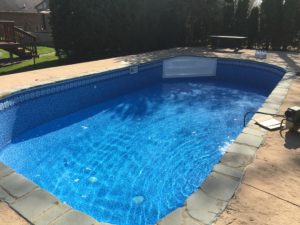 After you spend all the time, money, and energy creating your perfect backyard space complete with your ideal vinyl liner pool… the last thing you want to see is stains on your liner. Are they treatable? Are you going to have to replace your whole liner?
After you spend all the time, money, and energy creating your perfect backyard space complete with your ideal vinyl liner pool… the last thing you want to see is stains on your liner. Are they treatable? Are you going to have to replace your whole liner?
An advantage of vinyl liners is that they often don’t stain as much as plastic and metal in or around your pool. Vinyl liners can stain in localized areas and spread throughout the pool surfaces. It could be just one small pot, on the water line, on steps, or on the floor of the pool. The size, location, and color are important to identify the cause of the pool stain so you can properly identify and stop the source.
Start with testing your water for mineral content. Run the test for iron, manganese or copper.
How to identify vinyl stains: The most common pool stains are blue/green and are usually due to too much copper in the water. If you see brown/red/yellow staining that could be do to too much iron. Calcium or sodium salts typically leave a white deposits.
Organic pool stains come from dead algae, small animals, or organic debris. These stains normally occur after a long winter or thunderstorm.
Chemical pool stains or UV stains are more tricky to treat and are most likely un-treatable. They can occur do to bleaching of the vinyl liner or incorrect pH or chlorine levels.
Mineral vinyl liner stains respond best to acid treatments. However, you cannot treat vinyl liners with acid wash so you may be out of luck.
In order to treat your vinyl liner stains you first have to identify if it’s an organic stain or a chemical stain.
Preventing pool stains: As usual, keeping your pool water balanced and clean is important for keeping your pool stain free. This includes keeping up with your pool maintenance during the off-season as well as summer. If your pool water comes from a well it could contain high levels of minerals which could stain the pool. Use proper fill water and know where your water is coming from.
